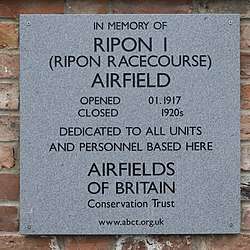RAF Ripon
Royal Air Force Ripon (also known as Royal Flying Corps Ripon) was a First World War airfield maintained by the Royal Flying Corps in the city of Ripon, North Yorkshire, England. The airfield was home to No. 76 Squadron which was employed on Home Defence (HD) in the United Kingdom. The airfield was created when the Royal Flying Corps (RFC) commandeered the southern half of Ripon Racecourse in 1916. After the end of the First World War, the airfield was returned to horse-racing.
| RAF Ripon RFC Ripon | |||||||
|---|---|---|---|---|---|---|---|
| Ripon, North Yorkshire in England | |||||||
 The plaque at Ripon Racecourse. This is affixed to the oldest building at the racecourse. | |||||||
 RAF Ripon RFC Ripon Location within North Yorkshire | |||||||
| Coordinates | 54°07′06.6″N 1°29′49.4″W | ||||||
| Type | Home Defence (HD) airfield | ||||||
| Area | 81 acres (33 ha) | ||||||
| Site information | |||||||
| Owner | Air Ministry | ||||||
| Condition | Open as racecourse | ||||||
| Site history | |||||||
| Built | 1916 | ||||||
| In use | 1919 | ||||||
| Garrison information | |||||||
| Occupants | No. 79 Squadron RAF No. 189 Squadron RAF | ||||||
| Airfield information | |||||||
| |||||||
History
In 1916, the southern part of Ripon Racecourse, only 2 miles (3.2 km) south-west of the city of Ripon,[1] was pressed into service as a base for No. 76 Squadron RFC.[2] No. 76 Squadron was employed on Home Defence duties and had individual flights located at Catterick, Copmanthorpe and Helperby,[3] with Ripon acting as the headquarters. Other landing grounds could be used in an emergency (RAF Manywells Height), though in practice, lesser used locations saw very little activity (if any).[4] As with the other landing grounds in Yorkshire, the site at Ripon was quite compact, covering only 81 acres (33 ha) with basic facilities. The role of 76 Squadron at the base was in countering any German threats from air, most notably the Zeppelin airships that would try bombing runs across the north.[5]
In 1917, No. 189 Squadron formed at RFC Ripon as a night training squadron and its stay at the airfield was short (only 5 months) before moving south to Suttons Farm.[6] On 1 April 1918, the Royal Air Force was formed from the RFC and the Royal Naval Air Service.[7] RFC Ripon was changed to Royal Air Force Ripon, though this name would only exist for 11 months.
No. 76 Squadron moved to Tadcaster in March 1919 and was disbanded there just three months later.[8] The airfield at Ripon was returned to the racecourse owners.[9] Even after this, the portion of the racecourse to the south was used to land civilian flights including Sir Alan Cobham's Circus in the 1920s.[10] The site was re-used during the Second World War as a Prisoner of War (PoW) camp.[11]
During the Second World War, RAF Dishforth, some 4 miles (6.4 km) to the east of Ripon was also commonly known as RAF Ripon due to its proximity to the town, but this was a purely unofficial name.[4] The town also had another civilian airfield, due south of the city, that existed briefly in the 1920s.[12]
References
- Halley 1980, p. 361.
- Delve, Ken (2006). Northern England : Co. Durham, Cumbria, Isle of Man, Lancashire, Merseyside, Manchester, Northumberland, Tyne & Wear, Yorkshire. Ramsbury: Crowood. p. 302. ISBN 1-86126-809-2.
- Rawlings, John D.R. (1976). Fighter squadrons of the RAF and their aircraft (2 ed.). London: Macdonald and Jane's. p. 192. ISBN 9780354010283.
- Halpenny, Bruce Barrymore (1990). Action stations (2 ed.). Wellingborough: Stephens. p. 158. ISBN 0-85059-532-0.
- "Ripon - UK Airfield Guide". www.ukairfieldguide.net. Retrieved 14 March 2018.
- Lake, Alan (1999). Flying units of the RAF : the ancestry, formation and disbandment of all flying units from 1912. Shrewsbury: Airlife. p. 179. ISBN 1-84037-086-6.
- "Get ready to start the celebrations to mark RAF 100". RAF News. High Wycombe: Royal Air Force (1392): 5. 8 April 2016. ISSN 0035-8614.
- Halley 1980, p. 114.
- Rapier, Brian J. (1980). White Rose Base (2 ed.). York: Air Museum York Publications. p. 76. ISBN 9780950732602.
- "Ripon I". www.acbt.org.uk. Retrieved 14 March 2018.
- Rogers, Simon (8 November 2010). "Every prisoner of war camp in the UK mapped and listed". The Guardian. No. 121. Retrieved 14 March 2018.CS1 maint: location (link)
- "Ripon II - Airfields of Britain Conservation Trust UK". www.abct.org.uk. Retrieved 13 March 2018.
Sources
- Halley, James J (1980). The Squadrons of the Royal Air Force. Tonbridge: Air-Britain. ISBN 0-85130-083-9.